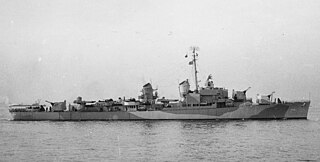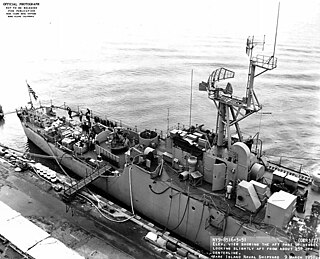
USS Fletcher (DD/DDE-445), named for Admiral Frank Friday Fletcher, was the lead Fletcher-class destroyer, and served in the Pacific during World War II. She received fifteen battle stars for World War II service, and five for Korean War service.

The third USS Farragut (DD-348) was named for Admiral David Glasgow Farragut (1801–1870). She was the lead ship of her class of destroyers in the United States Navy.

USS Gilmer (DD-233/APD-11) was a Clemson-class destroyer in the United States Navy during World War II. She was the first ship named for Secretary of the Navy Thomas Walker Gilmer.

USS Conway (DD/DDE-507), a Fletcher-class destroyer, was the second ship of the United States Navy to be named for William Conway, who distinguished himself during the Civil War.

USS Cony (DD/DDE-508), a Fletcher-class destroyer, was a ship of the United States Navy named for Joseph S. Cony (1834–1867), a naval officer during the Civil War.

USS Hambleton (DD-455/DMS-20) was a Gleaves-class destroyer of the United States Navy, named for Purser Samuel Hambleton (1777–1851).

USS Tillman (DD-641), a Gleaves-class destroyer, was the second ship of the United States Navy to be named for United States Senator Ben Tillman. In commission from 1942 to 1947, she saw service in World War II, primarily in the Atlantic and Mediterranean.

The third USS Perry (DD-340/DMS-17) was a Clemson-class destroyer in the United States Navy following World War I. She was one of eight ships named for Oliver Hazard Perry.

USS Robinson (DD-562), a Fletcher-class destroyer, was the second ship of the United States Navy to be named for Captain Isaiah Robinson, who served in the Continental Navy.

USS John R. Pierce (DD-753), an Allen M. Sumner-class destroyer, is the only ship of the United States Navy to be named for Lieutenant Commander John Reeves Pierce.

USS Hilary P. Jones (DD-427) was a Benson-class destroyer in the United States Navy during World War II. She was named for Admiral Hilary P. Jones.

USS Thaddeus Parker (DE-369) was a John C. Butler-class destroyer escort in service with the United States Navy from 1944 to 1946 and from 1951 to 1967. She was scrapped in 1968.

USS Swearer (DE-186) was a Cannon-class destroyer escort in the United States Navy during World War II. She was later transferred to the French Navy as Bambara.
USS Motive (AM-102) was an Auk-class minesweeper built for the United States Navy during World War II. She earned three battle stars for World War II service. She was decommissioned in 1946 and placed in reserve where she remained until struck from the Naval Vessel Register in December 1966. She was sunk as a target in April 1968.
USS Sage (AM-111) was an Auk-class minesweeper acquired by the United States Navy for the dangerous task of removing naval mines.

USS Herbert C. Jones (DE-137) was an Edsall-class destroyer escort built for the U.S. Navy during World War II. She served in the Atlantic Ocean and provided destroyer escort protection against submarine and air attack for Navy vessels and convoys.

USS Joyce (DE-317) was originally commissioned as a US Coast Guard Edsall-class destroyer escort built for the U.S. Navy during World War II. She served in the Atlantic Ocean and the Pacific Ocean and provided destroyer escort protection against submarine and air attack for Navy vessels and convoys. During its World War II service, on two different engagements with enemy submarines, the Joyce rescued survivors of the tanker SS Pan- Pennsylvania and its sister ship USS Leopold. Joyce received one battle star for its service during World War II.

USS Quest (AM-281) was an Admirable-class minesweeper built for the United States Navy during World War II. She was decommissioned in 1947 after wartime service and transferred to the Philippine Navy in 1948 where she served as presidential yacht RPS Pag-asa (APO-21). In 1955, she was renamed Santa Maria and, later, Mount Samat (TK-21), serving as a patrol corvette of the Miguel Malvar class. She was decommissioned from the Philippine Navy in 1970; beyond that, her fate is not reported in secondary sources.

USS Silverstein (DE-534) was a John C. Butler-class destroyer escort in service with the United States Navy from 1944 to 1947 and from 1951 to 1958. She was sold for scrapping in 1973.

USS Weber (DE-675/APD-75) was a Buckley-class destroyer escort of the United States Navy, named in honor of Ensign Frederick T. Weber (1916–1942), a naval aviator who was posthumously awarded the Navy Cross for heroism during the Battle of Midway.


















